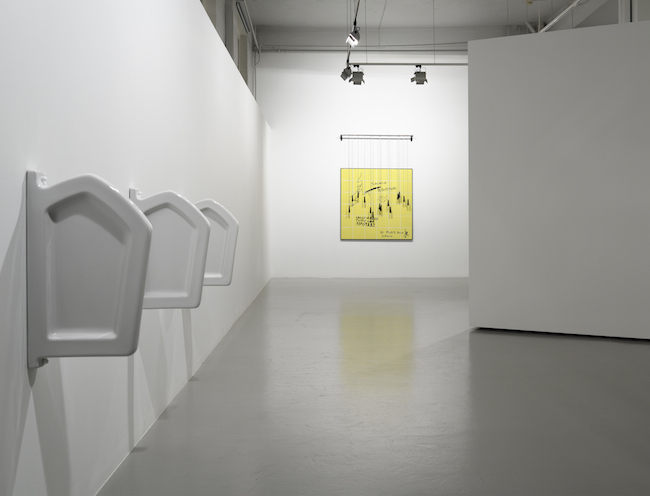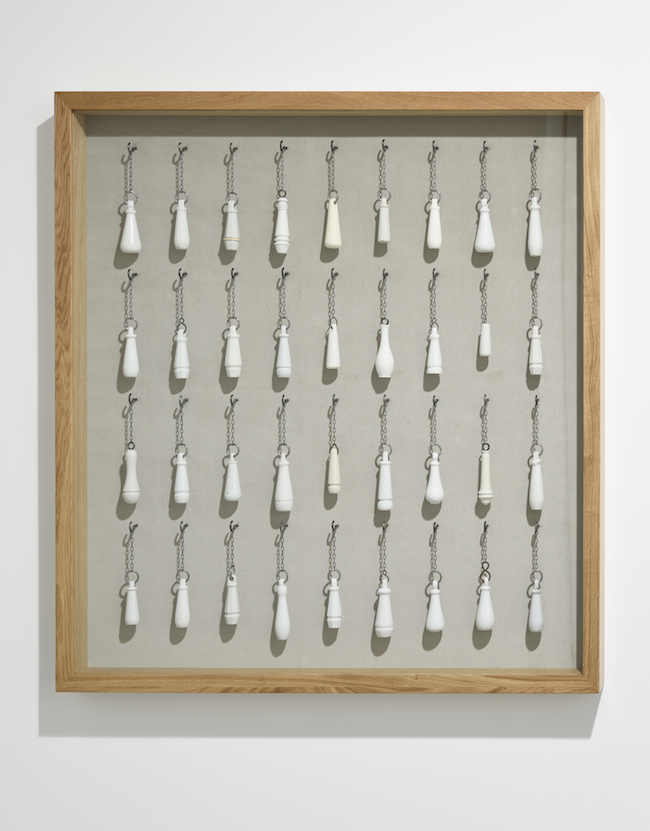
Stereotypical
20/02/2017
Jaanus Samma “Divider”
Temnikova & Kasela, Tallinn
Through March 11, 2017
Jaanus Samma’s latest solo exhibition “Divider”, at Temnikova & Kasela Gallery (through March 11, 2017), tackles the subject of public restrooms. Even though at first glance it might seem like a slippery slope to tackle, the artist touches upon many more and much deeper topics – ones which are not only connected to local history and culture, but that can also be brought out in front of a wider audience for discussion.

Jaanus Samma. Study of a Toilet, 2016 – 2017. Ink, paper, collage
Jaanus Samma is quite well known in the Baltic region – he won the Köler Prize (an Estonian contemporary art prize), and he was also chosen to exhibit at the Estonian Pavilion at the 56th Venice Biennale. He has been declared as being the hottest player on the Estonian art scene. This may be so, but I think that his work and subjects – his conceptual and analytical approaches, and at the same time, the aesthetic execution of his artworks – are the reason why his works and exhibitions have received such high praise.
The concept of the exhibition “Divider” is oriented towards marginal, peripheral areas in the urban environment, and focuses on public restrooms. However, this exhibition is more of a deconstruction of the idea of public toilets, in order to discuss subjects other than just restrooms. If we look at the idea of public toilets, the border between the public and the private becomes blurry, because even with the words “public restroom”, we suspect that it should be something private despite it actually being in the public domain. It is a situation that can’t be called either absolutely private or absolutely public.

Jaanus Samma. Flaminio Station II, 2017. Digital print, ceramic tiles, metal frame, rubber toilet pulls, chains, 178x121cm
Five works are exhibited in Temnikova & Kasela Gallery, and in different mediums – starting from men’s ‘urinal divider ready-mades’ and showcased porcelain toilet pulls, to elegant prints. As the purpose of this exhibition isn’t meant to be realistic, the artist plays with the details and has created them specially for the exhibition. In a way, Jaanus Samma has created pseudo-truthful objects. The objects in the exhibition look like they are real, but they also are not real. For example, the drawings on bathroom tiles have been copied from public spaces (most likely public toilets) and have been inserted in the exhibition space in oder to create a feeling of realness, but it is clear that they aren’t authentic objects. They aren’t real drawings on bathroom walls. On the other hand, another reappearing symbol/object, the porcelain toilet pull, has been created for this exhibition, but it is something that is slowly disappearing from the world as it is commonly replaced by knobs. It is a partly a historical object, but it exists in contemporary time as well. When one considers the toilet pull, it is something that appears in memories of olden times, from childhood – it isn’t an object that one would associate with the present. It is something old and something new, caught up in an interpretation.

Jaanus Samma. Study of a Toilet, 2016 – 2017. Ink, paper, collage
However, the most appealing part of the work “Study of a Toilet” are the little framed prints that depict every detail that is usually found in a normal restroom. It is like a recipe listing all of the ingredients necessary to make it a proper toilet. It is a proper study, from the point of view that it has copied a style of historical architectural example catalogues. In the nineteenth century, as well as before, it was common to gather different architectural examples in the format of prints and then publish them in encyclopaedias. It was an opportunity to disseminate different examples for various architects or artists to use in their work. Each print still exists in these enormous architectural encyclopaedias, and they represent different examples from various 19th-century architectural styles, starting from art nouveau bathrooms to different types of graveyard chapels and crypts. Every print was created in order to save these architectural monuments for posterity – they may already be gone, or if they’re still here, they will most likely disappear at some time in the future. In the exhibition, it is like praise for every little thing that probably can be found in most buildings – public or private. It is interesting how everyday objects, when presented in a historical style, can be suddenly brought into the spotlight. And not in an in-your-face way, but in a respectful and acknowledging way which also doesn’t care overly much. It is a distanced depiction of objects, but at the same time, it praises them. Although, it might not even be real praise.

Jaanus Samma. Flaminio Station I, 2017 . Digital print, ceramic tiles, metal frame, rubber toilet pulls, chains, 178x121cm
Upon entering the gallery, the first thing one sees is the “Urinal Divider”. It is an experience that one doesn’t really go through in women’s toilets, but at the same time, everyone knows that it exists. It brings me back to the exhibition text’s sentence: “The artist views men’s toilets as exclusively masculine environments that have, in different cultural and historical time-spaces, created ways for many forms of communication.” As a female writer, it is quite hard to look at the exclusivity and masculinity of men’s toilets, but it does raise the question about the division of genders concerning a subject that really isn’t discussed at all. Differentiating men’s and women’s toilets, and their supposed characteristics, raises stereotypes about each gender.
In terms of gender division, Latvian artist Katrīna Neiburga has a video work titled “What is in a girl’s handbag?” (2002). The resemblance between these two works lies in the subject of restrooms, but in Neiburga’s videos filmed in women’s toilets, she interviews women about the contents of their handbags. From one point of view, this video is anthropological research that shows how different people are, but at the same time, it also mythologizes the idea of what women do in public toilets: talk and put on make-up, making themselves beautiful in order to find a partner. But what happens in a truly masculine environment? Gender stereotypes of any kind put people in a divided space. Thinking about the idea, it would present certain stereotypes, which this exhibition doesn’t show directly. Thus, everything feels proper – the subject, the works, and the design of the exhibition.

Jaanus Samma. Collection of Toilet Pulls, 2017. Porcelain toilet pulls, showcase, 117x117cm
Knowing Jaanus Samma’s work beforehand, one might notice the continuum of his working methods and subjects. Even though Jaanus Samma changes mediums, his subject and approach continue down the same road, and it doesn’t really matter whether the work is being presented in a white cube gallery (such as Temnikova & Kasela Gallery), or is being exhibited in the vicinity of the public toilets of Rakvere for the art festival Kilometre of Sculpture, or if it’s being featured in the Estonian Pavilion at the 56th Venice Biennale.
All of these exhibitions are somehow connected. In his works, the private or the hidden becomes public, the historic becomes the present day, and the “masculine” is analysed. All of these contradictions bring me back to the questions of stereotypes. In terms of interpreting his work, it is impossible to remove oneself from the interpretations and certain stereotypes other people, or a certain group of people, might have. For example, the exhibition text already has different layers of meaning by way of not stating one definite idea. It is impossible to not make presumptions if one already knows the subjects of Jaanus Samma's other works. Being aware that Jaanus Samma works with gay subjects in Estonia, from both historic and contemporary perspectives, creates stereotypes about the exhibition, thereby allowing and making the viewer see the exhibition and the objects in a certain way. There are little signs all over the gallery space that introduce discussions about various subjects, but at the same time, it doesn’t go into some kind of poster-like representation. Consequently, it creates a situation in which, if one is aware of Jaanus Samma's previous works, one might over-interpret everything in the belief that one is finding the truth. In the end, it feels as if by interpreting his works, one is labelling and stereotyping. Yes, Jaanus Samma works with LGBT themes in his art; but he also interprets his subjects and creates new layers, bringing the hidden layers into the spotlight – because in this region of the world, the cultural history is such that there were certain subjects people couldn’t talk about; certain things were hidden in private. At some points, Samma’s exhibition “Divider” does divide certain subjects, but at the same time, it mostly deconstructs certain stereotypical ideas of interpretation and accepted norms.